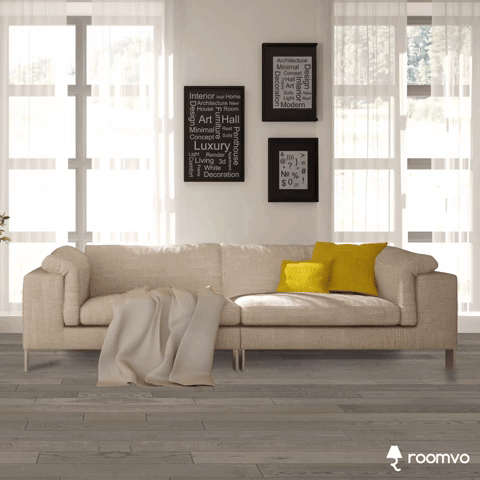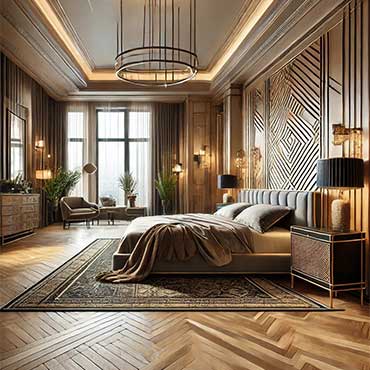Art Deco Interior Design: Timeless Elegance and Glamour for Your Home
Introduction
Art Deco, a style that epitomizes glamour, sophistication, and modernity, emerged in the early 20th century as a response to the austerity of previous design movements. Born in the roaring 1920s and flourishing into the 1930s, Art Deco celebrates luxury, innovation, and bold artistic expression. Its origins can be traced to the International Exhibition of Modern Decorative and Industrial Arts held in Paris in 1925. Today, its timeless appeal lies in its ability to combine opulence with functionality, making it a popular choice for those seeking to infuse their homes with elegance and drama.
Key Features of Art Deco Interior Design
Color Palette
Art Deco interiors often feature rich, dramatic colors paired with metallic accents. Black, gold, silver, and white are classic choices, creating a striking and glamorous contrast. Jewel tones like emerald green, ruby red, sapphire blue, and amethyst purple add vibrancy and depth, while soft pastel hues provide balance and sophistication.
Materials and Textures
Luxurious materials define Art Deco interiors. Think polished metals (chrome, brass, and stainless steel), glossy wood finishes, marble, and glass. Textiles like velvet, silk, and leather introduce tactile richness, while mirrored surfaces and lacquered finishes amplify light and space.
Furniture Style
Furniture in the Art Deco style is characterized by sleek, streamlined silhouettes and geometric forms. Pieces often showcase exotic shade, inlaid designs, and metallic accents. Key elements include curved lines, scalloped edges, and sunburst motifs, lending furniture a sculptural quality.
Patterns and Motifs
Bold, symmetrical patterns are a hallmark of Art Deco design. Chevron, zigzag, and geometric patterns are commonly seen on floors, textiles, and wallpaper. Iconic motifs like sunbursts, fans, and stylized flora and fauna add a touch of artistic flair.
Lighting
Lighting in Art Deco spaces is both functional and decorative. Statement fixtures, such as tiered chandeliers, pendant lights with frosted glass, and sleek sconces with geometric shapes, illuminate spaces with soft, ambient light. Materials like chrome, glass, and polished metal enhance the luminous effect.
Flooring in Art Deco Interior Design
Flooring plays a significant role in setting the foundation for the opulent and structured aesthetic of Art Deco interiors. True to the style’s emphasis on luxury and bold visual impact, Art Deco flooring options often incorporate rich materials, striking patterns, and a polished finish. Here are the key flooring elements in an Art Deco design:
Materials- Marble: Marble flooring, often in contrasting black-and-white checkerboard patterns or geometric designs, exudes elegance and timeless sophistication. The natural veining adds an organic touch to the otherwise structured aesthetic.
- Wood: High-gloss, dark-stained with intricate inlays or parquet patterns are a staple of Art Deco design. Exotic woods such as ebony or walnut were historically favored for their richness and depth.
- Tile: Glossy tiles with bold geometric patterns or metallic accents are commonly used, especially in bathrooms, kitchens, and entryways.
- entryways: This durable and artistic material, made from a mixture of marble chips and concrete, is a perfect flooring option for creating colorful, intricate designs.
Art Deco flooring is distinguished by its use of geometric and symmetrical patterns:
- Chevron and Herringbone: These patterns are often seen in hardwood or monochromatic, adding dynamic movement to the space.
- Radial Designs: Sunburst motifs or circular patterns, achieved through tile or wood inlays, reflect the style’s love of bold artistic statements.
- Checkerboard Patterns: Black-and-white tiles, especially in marble or stencil, are a classic choice that delivers high contrast and elegance.
The color palette for Art Deco flooring often mirrors the bold and luxurious tones used throughout the space:
- Neutral Tones: Black, white, and shades of gray serve as versatile backdrops for vibrant furniture and decor.
- Jewel Tones: Deep emerald greens, sapphire blues, or ruby reds are sometimes incorporated into terrazzo or tile designs for added drama.
A high-gloss finish is a hallmark of Art Deco flooring, reflecting light to enhance the space’s luminous and glamorous atmosphere. Polished marble, lacquered wood, and glazed tiles all contribute to this reflective quality.
Area Rugs and stencil Accents
While the flooring itself is often a statement, Art Deco interiors frequently incorporate luxurious rugs to soften and define spaces:
- Geometric Rugs: Bold, abstract designs in jewel tones or monochromatic palettes align perfectly with the Art Deco aesthetic.
- High-Pile Rugs: Plush rugs in materials like silk or velvet add texture and comfort while maintaining the luxurious vibe.
Art Deco flooring provides a foundation that is both functional and decorative, anchoring the room while setting the stage for the style’s iconic blend of drama and sophistication. Whether through marble tiles, intricate wood inlays, or bold bathrooms, the flooring in an Art Deco interior captures the essence of this glamorous design era.
Accessories and Decor
Art Deco accessories often include mirrored trays, sculptures, and vases with bold designs. Decorative items feature motifs like sunbursts, zigzags, and stylized animals. Large, framed mirrors with ornate details and abstract artwork in gilded frames complete the look.
Atmosphere and Appeal
Art Deco interiors exude sophistication, luxury, and a sense of drama. The combination of rich textures, bold patterns, and opulent materials creates an inviting yet glamorous ambiance. It resonates with audiences who appreciate vintage aesthetics, timeless elegance, and a touch of theatrical flair. This style offers a sense of escapism, transporting inhabitants and guests to an era of jazz, innovation, and architectural splendor.
How to Incorporate Art Deco Style into Your Home
Suitable Rooms or Spaces
- Living Rooms: Incorporate bold geometric rugs, velvet sofas, and statement lighting.
- Bedrooms: Opt for a sleek, high-gloss bed frame with a plush headboard and metallic accents.
- Bathrooms: Use black-and-white tiles, mirrored surfaces, and gold fixtures for a luxurious feel.
- Entryways: Make an impact with a dramatic chandelier, ornate mirrors, and patterned flooring.
Budget-Friendly Options
- Faux Finishes: Choose metallic spray paints and stick-on mirrors for affordable accents.
- Reproductions: Look for Art Deco-inspired furniture and decor at thrift stores or online marketplaces.
- DIY Projects: Create geometric wall art or stencil bold patterns onto furniture.
Popular Combinations with Other Styles
- Modern Art Deco: Pair sleek Art Deco elements with minimalist designs for a contemporary twist.
- Mid-Century Deco: Blend Art Deco’s opulence with the organic forms and simplicity of mid-century modern.
- Industrial Deco: Combine metallic finishes, exposed beams, and Art Deco lighting for a unique, edgy aesthetic.
Conclusion
Art Deco offers a timeless blend of luxury and creativity, making it an ideal style for those looking to make a bold design statement. Its rich history, elegant forms, and dramatic appeal can transform any space into a celebration of sophistication and artistry. Whether you’re incorporating a few key elements or fully embracing the style, Art Deco invites you to experiment with color, texture, and pattern to create a home that feels uniquely yours.

roomvo
Visualize Flooring In Your !
Roomvo makes picking new floors easy. Take advantage of our room visualizer tool to see what your home will look like with any flooring products from our catalog. Just upload your photo to see your room come to life.
 Blog
BlogBathroom - Art Deco
Transform Your Bathroom with Art Deco Flooring Elegance
Transforming a bathroom into an Art Deco-inspired haven requires careful attention to detail, with flooring serving as a foundational element in both functionality and design. This blog post by Arabella Whitethorn dives into the unique requirements of bathroom flooring, emphasizing how materials like durability and offer the perfect balance of durability, water resistance, and aesthetic appeal. Through a professional yet inspiring lens, the article explores how bold geometric patterns, polished finishes, and rich color palettes can align with the opulent, glamorous style of Art Deco interiors.
Addressing key considerations such as moisture exposure, budget, eco-friendliness, and design coherence, the post provides actionable insights tailored for interior designers and decorators. Whether working on a high-end renovation or a more modest project, this guide equips design professionals with the knowledge to select flooring that not only enhances the visual impact of a bathroom but also ensures practicality and longevity. With thoughtful advice and creative inspiration, the article helps readers create a sophisticated, functional retreat that captures the timeless allure of Art Deco design.
Learn More Blog
BlogArt Deco Bedroom - Solid Hardwood Flooring
Solid Hardwood Flooring for Art Deco Bedrooms: Timeless Elegance
In this blog post, Arabella Whitethorn explores the suitability of solid for an Art Deco-inspired bedroom. Delving into the key design elements of Art Deco, she highlights how hardwood complements its luxurious style with timeless appeal and customization options. The post examines nine critical factors—including durability, budget, and eco-friendliness—to provide a comprehensive guide for interior designers and decorators.
Arabella’s professional insights, paired with her sophisticated narrative style, offer valuable guidance for choosing flooring that enhances the ambiance and functionality of a bedroom. Whether opting for dark-stained walnut or light oak, readers will find inspiration and practical advice to create stunning Art Deco interiors.
Learn More